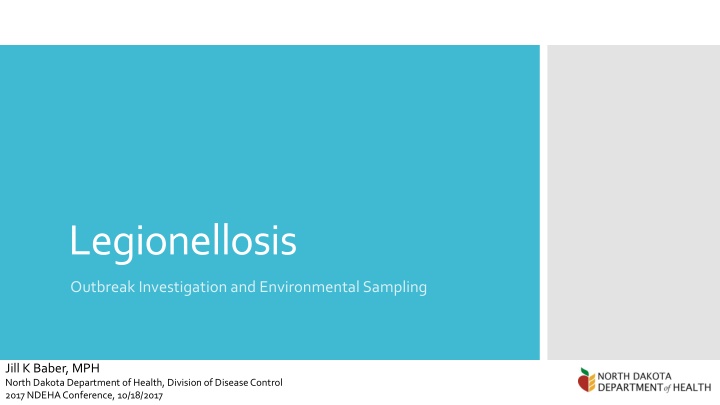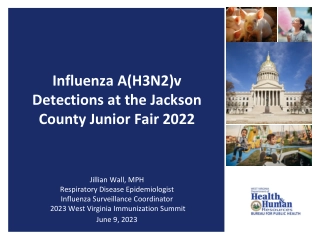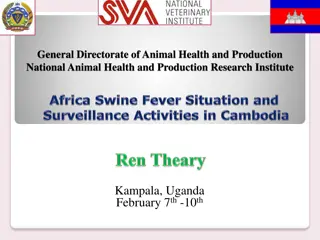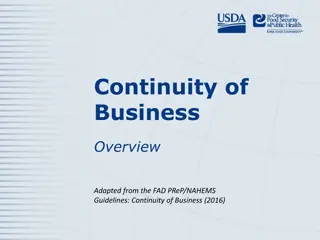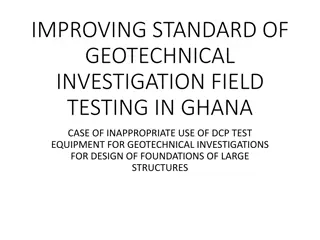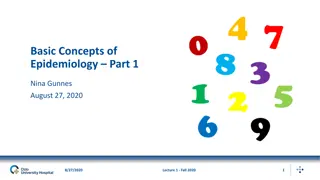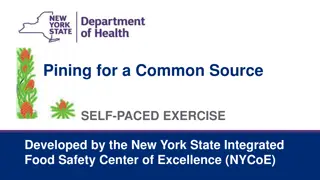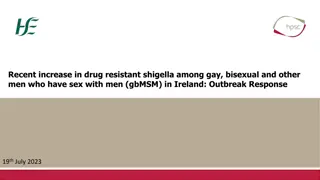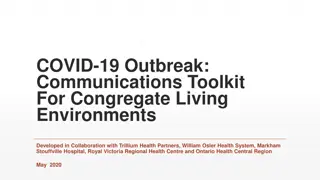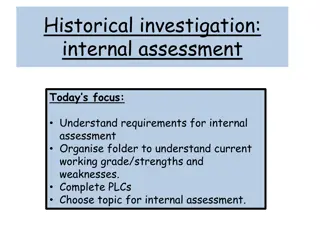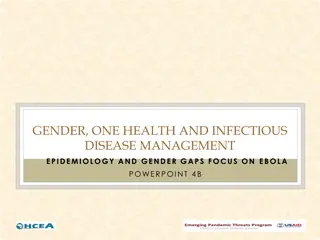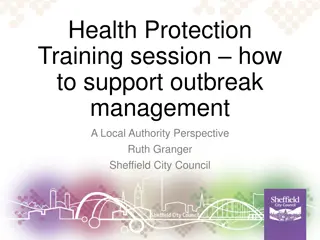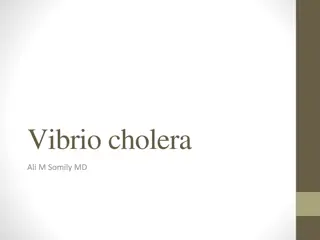Legionellosis Outbreak Investigation: Epidemiology and Clinical Presentation
Legionellosis, caused by Legionella bacteria, is a serious respiratory illness with various clinical presentations. Understanding the epidemiology, risk factors, and transmission routes is crucial for effective prevention and control of outbreaks. The history of Legionnaires' disease, clinical symptoms, transmission methods, and diagnostic challenges highlight the importance of public health surveillance and education.
Download Presentation

Please find below an Image/Link to download the presentation.
The content on the website is provided AS IS for your information and personal use only. It may not be sold, licensed, or shared on other websites without obtaining consent from the author.If you encounter any issues during the download, it is possible that the publisher has removed the file from their server.
You are allowed to download the files provided on this website for personal or commercial use, subject to the condition that they are used lawfully. All files are the property of their respective owners.
The content on the website is provided AS IS for your information and personal use only. It may not be sold, licensed, or shared on other websites without obtaining consent from the author.
E N D
Presentation Transcript
Legionellosis Outbreak Investigation and Environmental Sampling Jill K Baber, MPH North Dakota Department of Health, Division of Disease Control 2017 NDEHA Conference, 10/18/2017
1976 American Legion Convention, Philadelphia, PA Legionnaire s Disease was first identified after a large outbreak in July of 1976 related to an American Legion convention Convention attendees with unexplained pneumonia 221 cases 2/3 cases hospitalized 34 deaths Legionella pneumophila identified
Bacteria: gram-negative rods Serogroups and subtypes Legionella pneumophila, serogroup 1 accounts for ~70% of cases Waterborne Surface waters Building water systems Biofilms! Legionella Grows at 77-108 F Replicates in human white blood cells and protozoa
Clinical Presentation Pontiac Fever Legionnaires Disease Flu-like illness (fever, chills, cough) without pneumonia Pneumonia, fever, cough Hospitalization common Hospitalization uncommon Treated with antibiotics Symptoms resolve themselves 2-10 day incubation Fatality rate: 10% 1-3 day incubation Risk groups: age 50+, smokers, COPD sufferers, diabetics, the immunosuppressed Fatality rate: 0% No special risk groups
Human infections via aerosolization of contaminated water from things like: Showers and faucets Cooling towers Hot Tubs Decorative Fountains Legionellosis
Between 8,000 and 18,000 annual hospitalizations estimated About 4,000 annual deaths estimated Diagnosed most often via sputum culture or urine antigen test Underreported Patients recover without medical assistance Patients are not tested Patients misdiagnosed Legionellosis 20% of cases travel associated 96% of cases sporadic (not associated with a known outbreak)
General Epidemiology
Why the increase in incidence? More testing Better surveillance Aging population Aging infrastructure Warmer temperatures General Epidemiology
Cases with a laboratory diagnosis are reportable to the North Dakota Department of Health. North Dakota State-wide Legionellosis Incidence Rate by Year, 2006-2016 1 0.8 North Dakota Epidemiology 0.6 0.4 0.2 0 2006 2007 2008 2009 2010 2011 2012 2013 2014 2015 2016 ND Legionellosis Cases by Year Year 2006 2007 2008 2009 2010 2011 2012 2013 2014 2015 2016 Cases 1 2 3 2 6 3 3 3 4 5 5
All cases are investigated by NDDoH field epidemiologists Travel info Possible water exposures Possible healthcare exposures Clinical data EH personnel are alerted if possible exposure location identified North Dakota Case Investigation Because of the potential for outbreaks, including outbreaks in other states, Legionellosis is considered first priority, meaning case investigation is initiated within 24 hours. Data are sent within five days to the Centers for Disease Control and Prevention.
The NDDoH receives a notification if an out-of-state (or out-of- country) case traveled to North Dakota during their incubation period. NOT included in North Dakota case count Notification includes: Limited non-identifiable demographic data Location of stay Dates of stay Investigation prompted when more than one notification is received for a North Dakota building Travel- Associated Cases
Fresh water is reservoir for Legionella In nature, Legionella generally exists in insufficient quantities to cause disease Buildings can provide a more ideal environment for Legionella Better environment for to growth Opportunities for contaminated water to be aerosolized Legionella and the Built Environment
How do Legionella (and other pathogens) get into a building s water system? What factors promote growth of Legionella once inside a water system? Certain activities can introduce dirt and other materials into the system: Construction (new and renovation) Water main breaks Changes to municipal water quality The presence of biofilm, scale, and sediment Fluctuations in water temperature and/or pH Legionella and the Built Environment Inadequate levels of disinfectant Changes in water pressure These activities can help by either introducing Legionella or by introducing other materials that can use up available disinfectant. Water stagnation
Where can Legionella grow, spread, and aerosolize? Many places! Hot and cold water storage tanks Water heaters Expansion tanks Water filters Electronic and manual faucets Aerators Faucet flow restrictors Showerheads and hoses Pipes, valves, and fittings Centrally installed misters, atomizers, air washers, and humidifiers Nonstream aerosol-generating humidifiers Infrequently used equipment including eyewash stations Ice machines Legionella and the Built Environment Hot tubs Decorative Fountains Cooling towers Medical equipment CPAP machines Hydrotherapy equipment Bronchoscopes
Temperature C/ F State of Legionella <20 <68 Dormant but viable 35-46 95-115 Optimal growth 50 122 90% Kill in two hours 60 140 90% Kill in two minutes Water Temperatures >70 >158 100% Rapid kill
Building water systems offer a warm, enclosed space with regular access to air and water great for Legionella and other aerobic organisms! Biofilms can be difficult to remove How a single Legionella bacterium can contaminate your water system: attaches to biofilm replicates to form a microcolony colony matures bacteria break of colony to form new colonies on biofilm Biofilms some bacteria break of colony and continue in water system to end fixture
When the NDDoH discovers a building is a shared risk factor for two or more unrelated cases of Legionellosis, and outbreak investigation is prompted Outbreak Investigation A full investigation will include personnel from Disease Control, the Division of Microbiology, and local environmental health personnel
Additional case information obtained, including information about accommodations, and visits to surrounding attractions Outbreak Investigation An environmental assessment is conducted at the facility Samples as collected from various locations with in the facility for laboratory testing
Following an outbreak, the investigation team will view the facility and speak with building maintenance personnel; investigations include: Review of building water system, including building schematics, water management plants, sample results, and recent consultancies Tour of all buildings on the premises Sample collection from Environmental Assessment The NDDoH utilizes the CDC outbreak toolkit for outbreak investigation, which provides a comprehensive form for guiding the environmental investigation (see Resources slide)
During sample collection, the following is measured or obtained: 1. Chlorine residual levels 2. Water temperature 3. pH 4. Water Sample 5. Biofilm samples (swab) Environmental Assessment: Sample Collection It is important to make sure the right equipment and sufficient supplies are on hand to conduct an environmental assessment
Important equipment for samples collection can include: Sterile plastic 1 L bottles (at least one for every location that must be sampled) Sodium Thiosulfate Pipettes and bulbs Chlorine analyzer Thermometer Labels Chain of custody documentation Dacron-tipped swabs Sterile plastic screw top tubes Coolers or other equipment needed for transport Environmental Assessment: Sample Collection
Common locations where samples are collected can include: Sinks and showers Pools and hot tubs (including filters) Hot water heaters Water softening equipment Municipal point of entry Medical equipment that utilizes and holds water Decorative water features Any kind of water storage tank or device that is part of the water system Environmental Assessment: Sample Collection The CDC provides excellent training videos on how to collect and transport samples. These techniques can be used for both outbreak and routine sample collection (see Resources slide)
Collected samples will be analyzed for the presence of Legionella (results can take 10-14 days) After an Environmental Assessment The outbreak team with work with the CDC to create recommendations for remediation or future action Results and recommendations are provided to the facility Recommendations will be provided in writing; information for immediate action will also be provided verbally Failure to isolate Legionella in collected samples is does not indicate the facility is free from Legionella
ASHRAE recommends two methods to remove Legionella: 1. Hot water flush (160-170 F) 2. System chlorination (min 2 ppm, 2 hours) After an Environmental Assessment: Remediation Remember: Legionella identified at one point can could have come from anywhere upstream in the water system! Follow-up testing and system monitoring will occur after remediation May choose to engage a Legionella consultant
Ongoing control is important in reducing the burden of Legionellosis ASHRAE Proposed New Standard 188: Prevention of Legionellosis Associated with Building Water Systems Avoiding Outbreak through Water Management In response, the CDC has developed a toolkit to help building owners: Evaluate their water system Develop a water management plan if one is needed
New regulation to reduce Legionella (and other waterborne pathogen) risk in: Hospitals Skilled nursing facilities and nursing facilities Critical access hospitals New CMS Rule A response to outbreaks identified in hospitals and nursing homes High-risk populations Large, complex water systems Requires facilities to create and follow a water management plan
Question: Is routine testing for Legionella recommended? Answer: Sometimes! What About Routine Testing? Why test for the presence of Legionella? Following an outbreak or identified facility related case Yes! Validation of efficacy of water management program Maybe! (or, perform surveillance for Legionella infections) Regular monitoring of water quality parameters (i.e. disinfectant levels, temperature) is recommended as part of a water management program
Specific decisions about sample frequency, location, and methodology should be made by the building s water management team as part of a comprehensive water management program Sampling plans should be based on a variety of factors including: Environmental assessments and baseline Legionella data Performance of water management program and trend analysis of Legionella test and water quality parameter results Correlation of environmental testing results with clinical surveillance data Building characteristics (age, complexity, populations served) Sites of possible exposure to aerosolized water Available resources to support testing. Validation Testing
Where can Validation Samples be Sent? A private lab In the future, the NDDoH Division of Microbiology Will be fee-for-service An announcement will be made when this is available
Thank you! Jill Baber NDDoH Epidemiologist 701-328-3341 jbaber@nd.gov Questions?
CDC Legionella toolkit: https://www.cdc.gov/legionella/downloads/toolkit.pdf CDC Legionella Environmental Assessment Form: https://www.cdc.gov/legionella/downloads/legionella- environmental-assessment.pdf Resources CDC environmental investigation videos: https://www.cdc.gov/legionella/videos.html CMS Legionella and Other Waterborne Pathogens Surveyor Training Video: https://surveyortraining.cms.hhs.gov/pubs/VideoInformation.aspx ?id=134&cid=0CMSLEGWEB-Archived
